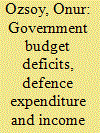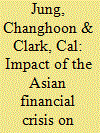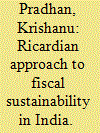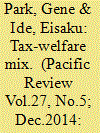|
|
|
Sort Order |
|
|
|
Items / Page
|
|
|
|
|
|
|
| Srl | Item |
| 1 |
ID:
137698


|
|
|
|
|
| Summary/Abstract |
Forward-looking approaches to fiscal sustainability generally assess the fiscal implications of future programme-specific expenditure. This article attempts to assess the future fiscal implications of the National Food Security Act (NFSA), 2013, for the Indian economy. The results, under the baseline scenario based on the projected debt–GDP ratio, indicate a modest increase till 2021–22 and then debt/GDP declines towards the current level of 70% in 2012–13, signifying fiscal sustainability. The dynamics of the projected baseline debt–GDP ratio are largely shaped by the provisions of the Act and underlying demographic factors during the projection horizon. Sensitivity analysis under different assumptions about productivity growth, the interest on government borrowing and primary deficit–GDP ratios show mixed results and hence provide necessary policy pointers towards restoring fiscal sustainability under the Act. Keeping the primary deficit–GDP ratio below 1.5 per cent through periodic upwards revisions in the issue price of food grains, as envisaged in the Act, coupled with higher productivity growth and lower interest on government debt, would ensure long-term fiscal sustainability of the Act.
JEL Classification: H24, H62, H68, J11, Q18
|
|
|
|
|
|
|
|
|
|
|
|
|
|
|
|
| 2 |
ID:
083227


|
|
|
|
|
| Publication |
2008.
|
| Summary/Abstract |
This paper analyzes the relationship between government budget deficits, defence expenditure and income redistribution among different social-income groups in Turkey for the period 1965-2003. The analysis was based on a five-equation vector auto regressive (VAR) model and impulse response functions (IRFs) derived from the VAR model. The study finds that the deficit as a percentage of GNP has a negative and significant impact on transfer payments as a percentage of GNP. The IRFs indicate that shocks to deficit expenditures as a percentage of GNP (DEFGNP) have statistically significant impacts on defence spending as a percentage of GNP (DSGNP), educational expenditures as a percentage of GNP (EDGNP), health expenditures as a percentage of GNP (HEGNP), and transfer payments as a percentage of GNP (TPGNP). The results derived from this study also indicate that there is a positive and significant relationship between defence spending as a percentage of GNP and deficits as a percentage of GNP. Therefore, defence spending is viewed as a tool for transferring income among different social-income groups and across generations in Turkey for the period 1965-2004. As a result of this, the government can use deficit and defence spending as one of the major instruments to transfer income among different social-income groups and across generations in Turkey.
|
|
|
|
|
|
|
|
|
|
|
|
|
|
|
|
| 3 |
ID:
096155


|
|
|
|
|
| Publication |
2010.
|
| Summary/Abstract |
The Republic of Korea was one of the major victims of the Asian Financial Crisis of 1997-98, but it recovered its economic dynamism quite quickly. In the short term, its budgetary response to near economic collapse was immediate and quite significant. The government increased spending and, once the peak of the crisis was over, taxes and expanded its previously very limited support of needy Koreans by substantially increasing funds for social development and for aiding local government. Thus, despite its being forced to accept a large International Monetary Fund (IMF) loan in late 1997, Korea clearly rejected the IMF model of fiscal austerity and governmental downsizing, giving a much higher priority to the welfare of its citizens. However, this short-term response to the devastating fallout from the crisis seems to have exacerbated several long-term challenges facing Korea. The liberal fiscal policy clearly contributed to the country's burgeoning debt problem, and there have been only limited attempts to improve the problems associated with public funds and special accounts. Unfortunately, political inertia makes a serious response to these long-term challenges unlikely in the near future.
|
|
|
|
|
|
|
|
|
|
|
|
|
|
|
|
| 4 |
ID:
148507


|
|
|
|
|
| Summary/Abstract |
There are several approaches to assessing the sustainability of a country’s public finances. Ricardian equivalence is one such approach, in which fiscal sustainability is defined in terms of the neutrality of generational welfare through government fiscal policy. The present work is an attempt to discuss and analyse fiscal sustainability in India in the context of Ricardian equivalence. Different forms of empirically testable equations for testing Ricardian equivalence are derived based on studies by Buiter and Tobin (1978), Kormendi (1983) and Kormendi and Meguire (1990). A key aspect of fiscal sustainability is to ensure generational equity as reflected in India’s Fiscal Responsibility and Budget Management (FRBM) Act, 2003. Based on availability of data, empirical evidence is against the presence of Ricardian equivalence, indicating that the fiscal policy India pursued during the study period (1974–2011) has been detrimental to generational welfare neutrality.
|
|
|
|
|
|
|
|
|
|
|
|
|
|
|
|
| 5 |
ID:
135073


|
|
|
|
|
| Summary/Abstract |
Despite having the highest level of public debt in the Organisation for Economic Co-operation and Development (OECD), higher than Greece or Italy, Japan has one of the lowest aggregate tax burdens of the advanced industrial democracies. This paper asks why Japan, once described as a strong developmental state, has had such a weak extractive capacity, an inability to raise revenues to confront deficits and public debt? In contrast to the existing explanations that focus on political institutions, partisan preferences, or economic globalization, this article argues that Japan's ‘tax–welfare mix’ – the combination of taxes and redistributive welfare polices – undermined the state's long-term capacity to secure adequate tax revenue. More than just a source of revenue, taxes can be used directly to achieve redistributive goals, such as targeting low taxes and exemptions to specific groups. This study shows how Japan's tax–welfare mix diminished its extractive capacity through three mechanisms: the political lock-in of a redistributive social bargain struck around low taxes, the timing and sequencing of its tax policy and welfare development, and the erosion of public trust, which undermined tax consent. Beyond offering a new theory of extractive capacity, the tax–welfare mix explains aspects of Japan's tax structure that defy existing explanations and contributes to our understanding of the capitalist development state by highlighting the redistributive political function of tax policy and its long-term impact on state capacity.
|
|
|
|
|
|
|
|
|
|
|
|
|
|
|
|
| 6 |
ID:
163309


|
|
|
|
|
| Summary/Abstract |
The United States’ annual budget deficit is set to reach nearly $1 trillion this year, more than four percent of GDP and up from $585 billion in 2016. As a result of the continuing shortfall, over the next decade, the national debt—the total amount owed by the U.S. government—is projected to balloon from its current level of 78 percent of GDP to 105 percent of GDP. Such huge amounts of debt are unprecedented for the United States during a time of economic prosperity.
|
|
|
|
|
|
|
|
|
|
|
|
|
|
|
|
|
|
|
|
|